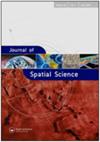编辑
IF 1
4区 地球科学
Q4 GEOGRAPHY, PHYSICAL
引用次数: 0
摘要
《空间科学杂志》2022年9月号始终是一个重要问题,因为它包括《空间科学期刊》编委会颁发的最佳研究论文奖得主的公告。该奖项每年根据2021年7月1日至2022年6月30日期间发表的同行评审研究和评审论文颁发。该奖项的详细信息载于本期。再一次,是时候告别我们编辑委员会的一位重要成员了。巴黎Télécom教授Florence Tupin博士在《空间科学杂志》编委会任职多年,并为该领域的许多论文的同行评审贡献了她的专业知识。Tupin博士对质量的执着和对同行评审和手稿开发的积极态度受到了极大的赞赏。2021年的影响因素也已发布,《空间科学杂志》保持了1.840的稳定影响因素,同时地理、物理类的影响因素比第三季度有所改善。感谢我们的作者、订阅者和编委会成员提供的支持。本期发表的论文为空间科学的当前研究和实践提供了有趣的见解。多边形地图投影很少用于世界地图,因为传统的多边形地图没有有利的失真模式。Kerkovits的这篇论文证明了这些投影的广义版本可以很好地调整为全球地图。对公式进行了数值优化,以确保投影具有尽可能低的失真。此外,还发展了具有进一步限制(例如矩形网格,等面积)的最优缩聚映射。Jouybari、Bagherbandi和Nilfouroushan使用三种不同的程序来分析IMU和GNSS的不确定性对其最终调整结果的影响。结果表明,分块GNSS偏移校正方法是一种较好的空中三角测量方法。检查点RMS残差的比较表明,分块解决方案平均比条带解决方案精确6cm。Rosas及其同事评估了使用低成本材料对多光谱图像进行辐射校准的情况。测试了四种材料:涂有哑光漆的胶合板;用合成纳帕皮革覆盖的胶合板;乙烯乙酸乙烯酯面板和覆盖有聚氯乙烯帆布的胶合板面板。确定了所有材料的使用寿命以及与校准相关的误差。生成最近邻模型的标准算法确定每对节点之间的距离,从而产生二次运行时间。这种时间复杂性在空间问题中很常见,并阻碍了《空间科学杂志2022》第67卷第3期355–357的出版https://doi.org/10.1080/14498596.2022.2107803本文章由计算机程序翻译,如有差异,请以英文原文为准。
Editorial
The September 2022 issue of the Journal of Spatial Science is always an important issue as it includes announcement of the winner of the Best Research Paper Award made by the Journal of Spatial Science Editorial Board. The award is made annually based upon peer reviewed research and review papers published in the twelvemonth period from 1 July 2021 to 30 June 2022. Details of the Award are contained in this issue. Once again, it comes time to farewell one of our valued members of the Editorial Board. Dr Florence Tupin, Professor at Télécom Paris, has served on the Editorial Board of the Journal of Spatial Science for several years and has contributed her expertise to peer review of many submissions in her field. Dr Tupin’s dedication to quality and inciteful approach to peer review and manuscript development is greatly appreciated. Impact factors for 2021 have also been released with the Journal of Spatial Science maintaining a steady impact factor of 1.840 accompanied by an improvement to Q3 in the Geography, physical category. Thank you for the support provided by our authors, subscribers and Editorial Board Members. Papers published in this issue provide interesting insights into current research and practice in the spatial sciences. Polyconic map projections are rarely used for world maps because traditional polyconic mappings do not have a favourable distortion pattern. This paper by Kerkovits demonstrates that the generalised versions of these projections can be adjusted well for global maps. The formulae are optimised numerically to ensure that the projections have as low distortion as possible. Furthermore, optimal polyconic mappings with further restrictions (e.g. rectangular graticules, equal-area) are also developed. Jouybari, Bagherbandi and Nilfouroushan use three different procedures to analyse the effect of IMU and GNSS uncertainties on their final adjusted results. The outcome suggests that the method of block-wise GNSS shift correction is a better method for aerial triangulation. A comparison of checkpoint RMS residuals shows that the block-wise solution is on average 6 cm more accurate than the strip-wise solution. Rosas and colleagues evaluated the use of low-cost materials for radiometric calibration of multispectral images. Four materials were tested: plywood panels painted with matte paint; plywood panels covered with synthetic nappa leather; ethylene vinyl acetate panels, and plywood panels covered with polyvinyl chloride canvas. The useful life of all materials and errors associated with their calibration were determined. The standard algorithm for generating nearest-neighbour models determines the distance between every pair of nodes, resulting in quadratic running time. Such time complexity is common among spatial problems and impedes the generation of larger JOURNAL OF SPATIAL SCIENCE 2022, VOL. 67, NO. 3, 355–357 https://doi.org/10.1080/14498596.2022.2107803
求助全文
通过发布文献求助,成功后即可免费获取论文全文。
去求助
来源期刊

Journal of Spatial Science
地学-地质学
CiteScore
5.00
自引率
5.30%
发文量
25
审稿时长
>12 weeks
期刊介绍:
The Journal of Spatial Science publishes papers broadly across the spatial sciences including such areas as cartography, geodesy, geographic information science, hydrography, digital image analysis and photogrammetry, remote sensing, surveying and related areas. Two types of papers are published by he journal: Research Papers and Professional Papers.
Research Papers (including reviews) are peer-reviewed and must meet a minimum standard of making a contribution to the knowledge base of an area of the spatial sciences. This can be achieved through the empirical or theoretical contribution to knowledge that produces significant new outcomes.
It is anticipated that Professional Papers will be written by industry practitioners. Professional Papers describe innovative aspects of professional practise and applications that advance the development of the spatial industry.
 求助内容:
求助内容: 应助结果提醒方式:
应助结果提醒方式:


